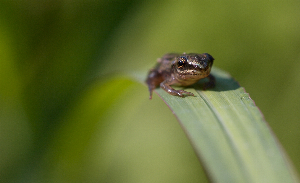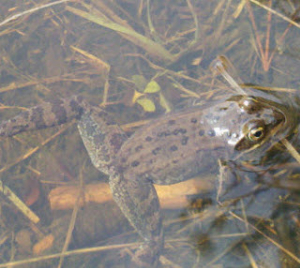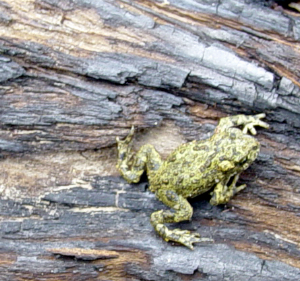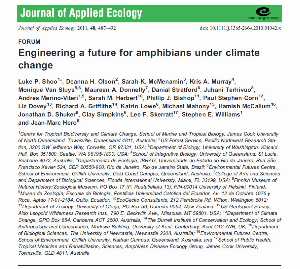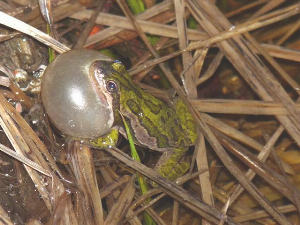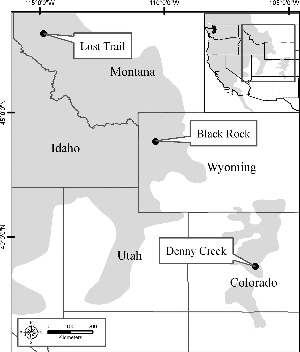Search ARMI Database
Search term(s)
Contribution Number
Search Results
70 record(s) found.
Papers & Reports Multi-species amphibian monitoring across a protected landscape: critical reflections on 15 years of wetland monitoring in Grand Teton and Yellowstone national parks
Papers & Reports Twenty-nine years of population dynamics in a small-bodied montane amphibian
Papers & Reports First Estimates of the Probability of Survival in a Small-bodied, High Elevation Frog or, how Historical Data Can Be Useful
Papers & Reports Trends in Rocky Mountain Amphibians and the Role of Beaver as a Keystone Species
Papers & Reports Breeding site heterogeneity reduces variability in frog recruitment and population dynamics
Papers & Reports Population-level thermal performance of a cold-water ectotherm is linked to ontogeny and local environmental heterogeneity
2. Habitat use, vulnerabilities and mechanisms for coping with local conditions can differ among populations and ontogentically within populations, potentially affecting species-level responses to climate change. However, we still have little knowledge of mean thermal performance for many vertebrates, let alone variation in performance among populations. Assessment of these sources of variation in thermal performance is critical for projecting the effects of climate change on species and for identifying management strategies to ameliorate its effects.
3. To gauge how populations of the Rocky Mountain tailed frog (Ascaphus montanus) might respond to long-term effects of climate change, we measured the ability of tadpoles from six populations in Glacier National Park (Montana, USA) to acclimate to a range of temperatures. We compared survival among populations according to tadpole age (age 1-yr or 2-yr) and according to the mean and variance of late-summer temperatures in natal streams.
4. The ability of tadpoles to acclimate to warm temperatures increased with age and with variance in late-summer temperature of natal streams. Moreover, performance differed among populations from the same catchment.
5. Our experiments with a cold-water species show that population-level performance varies across small geographic scales and is linked to local environmental heterogeneity. This variation could influence the rate and mode of species-level responses to climate change, both by facilitating local persistence in the face of changes in thermal conditions, and by providing thermally-tolerant colonists to neighbouring populations.
Papers & Reports Trends in amphibian occupancy in the United States
Papers & Reports Roles of habitat, restoration, and drought frequency in driving long-term trends of a widespread amphibian
Keywords:
Papers & Reports The state of the amphibians in the United States
Papers & Reports Disease in a dynamic landscape: Host behavior and wildfire reduce amphibian chytrid infection
Papers & Reports Interactive effects of wildfire, forest management, and isolation on amphibian and parasite abundance
populations and communities worldwide, including host–parasite relationships. Research in
temperate forests has shown that wildfire can negatively affect amphibians, but this research
has occurred primarily outside of managed landscapes where interactions with human
disturbances could result in additive or synergistic effects. Furthermore, parasites represent a
large component of biodiversity and can affect host fitness and population dynamics, yet they
are rarely included in studies of how vertebrate hosts respond to disturbance. To determine
how wildfire affects amphibians and their parasites, and whether effects differ between
protected and managed landscapes, we compared abundance of two amphibians and two
nematodes relative to wildfire extent and severity around wetlands in neighboring protected
and managed forests (Montana, USA). Population sizes of adult, male long-toed salamanders
(Ambystoma macrodactylum) decreased with increased burn severity, with stronger negative
effects on isolated populations and in managed forests. In contrast, breeding population sizes
of Columbia spotted frogs (Rana luteiventris) increased with burn extent in both protected and
managed protected forests. Path analysis showed that the effects of wildfire on the two species
of nematodes were consistent with differences in their life history and transmission strategies
and the responses of their hosts. Burn severity indirectly reduced abundance of soil-transmitted
Cosmocercoides variabilis through reductions in salamander abundance. Burn severity also
directly reduced C. variabilis abundance, possibly though changes in soil conditions. For the
aquatically transmitted nematode Gyrinicola batrachiensis, the positive effect of burn extent on
density of Columbia spotted frog larvae indirectly increased parasite abundance. Our results
show that effects of wildfire on amphibians depend upon burn extent and severity, isolation,
and prior land use. Through subsequent effects on the parasites, our results also reveal how
changes in disturbance regimes can affect communities across trophic levels.
Papers & Reports Rapid increases and time-lagged declines in amphibian occupancy after wildfire
Papers & Reports Estimating occupancy in large landscapes: evaluation of amphibian monitoring in the Greater Yellowstone Ecosystem.
Papers & Reports Temperature, hydric environment, and prior pathogen exposure alter the experimental severity of chytridiomycosis in boreal toads
Papers & Reports Engineering a future for amphibians under climate change
<br />
2. We identify management actions from across the world and from diverse disciplines that are applicable to minimizing loss of amphibian biodiversity under climate change. Actions were grouped under three thematic areas of intervention: (i) installation of microclimate and microhabitat refuges; (ii) enhancement and restoration of breeding sites; and (iii) manipulation of hydroperiod or water levels at breeding sites.<br />
<br />
3. Synthesis and applications. There are currently few meaningful management actions that will tangibly impact the pervasive threat of climate change on amphibians. A host of potentially useful but poorly tested actions could be incorporated into local or regional management plans, programmes and activities for amphibians. Examples include: installation of irrigation sprayers to manipulate water potentials at breeding sites; retention or supplementation of natural and artificial shelters (e.g. logs, cover boards) to reduce desiccation and thermal stress; manipulation of canopy cover over ponds to reduce water temperature; and, creation of hydrologoically diverse wetland habitats capable of supporting larval development under variable rainfall regimes. We encourage researchers and managers to design, test and scale up new initiatives to respond to this emerging crisis.
News & Stories Meeting Session Highlights ARMI
A dedicated session highlighting studies conducted by the USGS Amphibian Research and Monitoring Initiative (ARMI) in the West was held at the joint annual meeting of the Society for Northwestern Vertebrate Biology and Washington Chapter of The Wildlife Society at Gig Harbor, Washington on March 25th. The session, organized by Steve Corn, Research Zoologist at the Northern Rocky Mountain Science Center in Missoula, Montana, included presentations by ARMI scientists from five different science centers and addressed the main themes of ARMI since its inception in 2000: monitoring of status and trends of amphibian populations, research into causes of amphibian declines, and development of new sampling methods.
Presenters, followed by the title of their talks, included: Gary Fellers, Western Ecological Research Center, Point Reyes National Seashore, CA (Population size, survival, longevity, and movements of Rana draytonii, and R. sierrae at two closely monitored sites: tracking population trends); Mike Adams, Forest and Rangeland Ecosystem Science Center, Corvallis, OR (Does the probability of local extinction for northern red-legged frogs relate to introduced fish or bullfrogs?); Nate Chelgren, Forest and Rangeland Ecosystem Science Center, Corvallis, OR (Spatial and temporal variation in the demography of coastal tailed frogs (Ascaphus truei): isolating aquatic from terrestrial stage dynamics); Erin Muths, Fort Collins Science Center, Fort Collins, CO (Compensatory effects of recruitment and survival on population persistence); Tara Chestnut, Oregon Water Science Center, Portland, OR, (The ecology of the amphibian chytrid fungus, Batrachochytrium dendrobatidis in the aquatic environment); Blake Hossack, Northern Rocky Mountain Science Center, Missoula, MT (Wildfire and fragmentation: effects on amphibian populations and associated nematodes); David Pilliod, Forest and Rangeland Ecosystem Science Center, Boise, ID (Introducing an automated pattern recognition program for leopard frogs); and Steve Corn, Northern Rocky Mountain Science Center, Missoula, MT (How well do call indices represent abundance of breeding anurans?).
Papers & Reports Breeding chorus indices are weakly related to estimated abundance of boreal chorus frogs
Papers & Reports Long-Term Observations of Boreal Toads at an ARMI Apex Site
Long-term observations at other ARMI apex sites have proven invaluable for studying effects of climate change on amphibian behavior, and the Black Rock site has been upgraded with on-site recording of temperature and precipitation, and auditory monitoring of other amphibian species. Continued research at Black Rock will be critical for understanding the interrelated effects of climate and disease on amphibians in the Greater Yellowstone Ecosystem.

